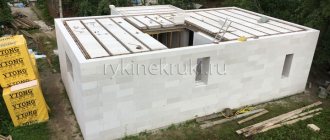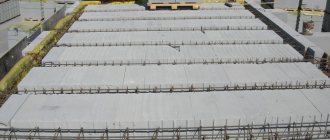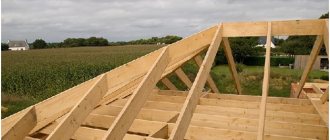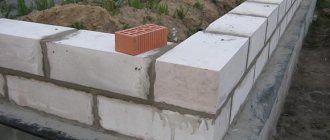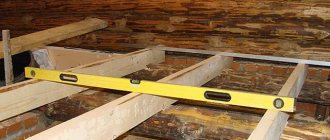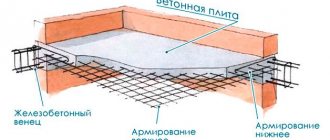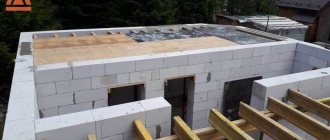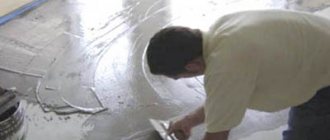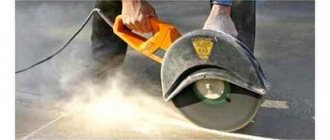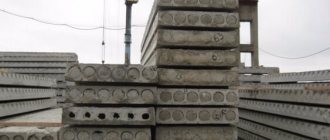When constructing buildings, builders have to solve various problems. One of them is the construction of a durable ceiling in a house made of foam blocks. Building a house from light blocks does not require a long time. At the same time, due to the insufficient strength of foam blocks, there are peculiarities in the execution of work. Depending on the number of floors of the building, the ceiling can be performed above the basement, as well as between floors. Ceiling - absorbs forces from the roof of the building and redistributes it to the load-bearing walls. It also serves as additional thermal insulation.
Floors for houses made of foam blocks - types of designs
The ceiling is the loaded part of the structure. The strength of the building and service life depend on the quality of workmanship. The following ceiling designs are used:
- whole. Monolithic roofing of a house made of foam blocks is a proven solution with many advantages. It allows you to form a seamless base with perfect flatness. The absence of joint areas increases thermal insulation properties and strength. The construction of a solid ceiling is a complex and labor-intensive process that requires special skills and high qualifications;
In order to make ceilings in a house from aerated concrete or foam blocks, you need to decide on the choice of materials and technologies
- prefabricated monolithic. Composite floors for houses made of foam blocks are constructed on the basis of standard concrete blocks produced in industrial conditions. During the manufacturing process, formwork is also constructed using thermal insulation materials. For this purpose, ready-made concrete elements are used, to which expanded clay or polystyrene is added. In this case, the areas where the elements are joined need to be sealed;
- team. This design can be constructed in a limited time and does not require increased costs. To form a composite ceiling, standard elements are used - reinforced concrete floor slabs, steel profiles or wood beams. The construction of a prefabricated structure is carried out using lifting mechanisms, followed by sealing the gaps between the parts.
When deciding on the flooring option, it is important to take into account the purpose of the building, the number of floors, and also minimize the level of upcoming costs.
We are building a house
Construction of walls from foam concrete blocks.
The construction of any house, be it a summer house or a country cottage, begins with the selection of a site, a suitable project and with calculations of construction costs.
Today, those wishing to build their own home have a very large choice among cottage-type country villages of different levels. In such villages, all the infrastructure has already been thought out, communications and roads have been installed.
Organizations developing these territories offer buyers a choice of various projects and turnkey construction of houses from foam blocks or other materials.
If a potential buyer does not have enough funds for the building that he chooses as a result, then developers can offer the construction of houses from foam blocks on credit.
If you want to reduce the cost of building a house from foam blocks, then you need to understand what stages of construction you will have to go through.
Step-by-step construction of a house made of foam blocks involves the following stages of work:
- laying the foundation;
- walling;
- installation of floors;
- roof installation;
- closing the circuit (installing windows and doors);
- laying utilities;
- flooring;
- installation of partitions;
- Finishing work.
Let's look at some of the stages of building a house made of foam blocks.
Foundation
The photo shows the construction of a pile-strip foundation.
The construction of a foam block house begins, like any other construction, with laying the foundation. But houses made of foam blocks are distinguished by the fact that they are lightweight compared to brick ones.
And if so, then the foundation does not need to be particularly reinforced, which will reduce construction costs and construction time.
It is recommended to lay foundations for houses made of foam blocks in two types:
- pile-tape;
- slab.
When constructing a two-story residential building made of foam blocks in central Russia, where loamy soils predominate, the following parameters are sufficient for laying columnar strip foundations:
- drilling depth for support pillars – 1.6 m;
- The step for installing support pillars under the grillage is 1.5 m.
The basis of such a foundation is frames made of reinforcement, which are filled with concrete. Removable formwork is used to form concrete structures.
Experienced builders of houses made of foam blocks lay such a foundation using new technologies, when holes for pillars are not dug and formwork is not installed in them.
Wells are drilled with special drills, which are waterproofed and serve as the formwork themselves for constructing piles for the foundation.
The second option for foundations, which are recommended when constructing houses from foam blocks, is a slab foundation.
Its name speaks for itself. A slab is being poured under the house. The difference between such foundations is that they are rigidly spatially reinforced throughout the entire volume.
Reinforcement of slab foundations.
The depth of the slab foundation is directly dependent on the weight of the house being built and for foam block structures is usually taken to be 30 - 50 cm.
Walls
The next stage of construction is the construction of the walls of the building. Foam concrete blocks are very easy to cut, drill and saw. When working with them, you can use both hand and power tools. (see more in the article Do-it-yourself foam block wall - a strong and reliable structure)
The good thing about building a house from foam blocks is that you can lay it not with mortar, but with special glue. This facilitates the laying process itself and eliminates the appearance of “cold bridges” in the walls, which cannot be avoided when using conventional mortar.
Important. It is necessary to make waterproofing between the masonry and the foundation; it will prevent water from penetrating into the pores of the block. For these purposes, roll bitumen materials are used. You can also use special waterproofing polymer-cement mixtures.
Floors
Floors in a foam concrete house can be of several types:
- prefabricated reinforced concrete;
- monolithic reinforced concrete;
- frame - hemmed;
- prefabricated - monolithic from gas silicate blocks.
Covering a house with foam blocks - the main requirements
Taking into account the properties of foam concrete blocks, the number of floors of a foam block house should not exceed three floors. The low strength characteristics of the porous material do not allow its use for the construction of multi-story buildings.
If the building is built using materials such as aerated concrete or foam block, the ceiling can be installed using several technologies
The ceiling structure for a building made of cellular blocks proportionally distributes forces on the main walls and performs a number of tasks:
- ensures the rigidity of the frame of the building being constructed;
- securely binds the walls, increasing the strength of the structure;
- effectively absorbs external noise;
- accepts the mass of building structures while maintaining integrity;
- insulates the living space, making it difficult for cold air to enter;
- increases fire safety through the use of non-combustible materials.
To increase the rigidity of the main walls of the building and protect the foam concrete from deformation, a reinforced belt is constructed around the perimeter of the walls. It forms a solid foundation for the construction of the ceiling structure.
Monolithic structures
For monolithic floors, concrete for pouring cannot be prepared independently.
In a house made of foam concrete and aerated concrete, it would be quite advisable to use this type of flooring.
Positive qualities of this type:
- Cost-effective;
- Fire safety;
- Durability;
- Wide availability of materials for work;
- Simple installation technology.
Self-made concrete is not suitable for this type of work. It is necessary to use concrete produced on an industrial scale, since production has certain requirements and standards that are controlled by the state. If you make your own concrete, you cannot guarantee that it will meet the standards. Of course, this is also unsafe, because we are talking about building material.
The construction of a monolithic interfloor ceiling has a number of difficulties:
- Concrete needs to be lifted to a great height, so the use of a concrete pump is necessary.
- It is necessary to use formwork throughout the entire work area.
The formwork must be made with high quality and strength; it will have to withstand the weight of the concrete mixture (on average 500 kg per 1 sq.m. with a concrete layer of 15 cm) and have some additional safety margin, because the load increases when pouring concrete from a concrete pump.
To construct the formwork, you need to use timber of at least 100×100 mm and plywood panels with a thickness of at least 18-20 mm. When the formwork is ready, make sure it is horizontal using a level.
The quality of the resulting floor depends on the quality of the formwork installation.
Stages of formwork assembly:
- installation of vertical supports (at least 1 m from each other);
- laying on board supports (50-70 mm);
- laying on top of the entire structure of boards that will serve as the basis for the formwork.
To avoid concrete leakage, the formwork must fit tightly to the wall.
To avoid errors and inaccuracies, it is best to install formwork under the guidance of a specialist. By saving on an experienced specialist, you not only risk doing defective work, but also compromising the integrity of the building itself.
Pouring the structure includes the following steps:
- Laying roofing felt on the bottom of the formwork.
- Tying reinforcement (at least 50 mm from the bottom of the formwork).
- Pouring concrete in a layer of 10-15 cm (if it is thinner, the floors may not be able to withstand it; if it is thicker, the load-bearing walls may not be able to withstand it).
After the concrete has been poured, it is necessary to give it time to harden - at least 20 days, and preferably 30.
Solid foam concrete floor
Concreting a solid ceiling is done with a concrete mixture with increased strength properties. Industrially produced concrete is used.
The reliability of the floor is the main point that determines the strength of the building. When performing work it is prohibited:
- use a solution produced by handicraft methods in concrete mixers;
- prepare portions and gradually pour the concrete mixture into the formwork;
- use low-quality concrete composition with a heterogeneous structure.
A building for the construction of which aerated concrete or foam block is used is a rather specific design.
When constructing the floor of a house from foam concrete blocks, it is important to follow the following recommendations:
- use a concrete pump to transport concrete mixture to a height;
- pour concrete into formwork with a pre-installed load-bearing frame.
The monolithic base has a number of advantages:
- increased load capacity;
- long period of use;
- fire and environmental safety;
- availability of building materials used.
Concreting technology can hardly be called simple, but this method of constructing a ceiling can be implemented in the construction of private houses.
The advantages of a one-piece design also include:
- the possibility of filling the ceiling with an increased distance between load-bearing walls;
- creation of a ceiling base with a non-standard configuration of the walls of the building being constructed.
Disadvantages of this design solution:
- the complexity of calculations to confirm the load capacity of walls;
- long concrete hardening time;
- the need to use equipment for preparing and supplying concrete;
- the complexity of preparation for pouring and the dependence of the quality of the base on the recipe;
- It is problematic to perform work at subzero temperatures.
Despite the laboriousness and complexity of the pouring process, they are preferred by builders, thanks to the ideal surface of the array.
The critical part of the monolithic ceiling is the formwork. Its strength should allow it to withstand the weight of the concrete mixture.
Various types of formwork are used for pouring:
- inventory, consisting of standard panel elements;
- self-made, made of wood or metal.
To fill a solid ceiling, install the formwork according to the following algorithm:
- Install vertical supports.
- Secure the horizontal bars.
- Assemble the formwork base.
- Seal gaps thoroughly.
- Place the load-bearing frame in the formwork, ensuring a distance of 4 cm from the level of the boards.
Supply the concrete mixture into the formwork using a concrete pump. Pour concrete until a thickness of 16–18 cm is reached. The concrete will reach serviceable strength 4 weeks after concreting. You can disassemble the formwork and continue further work.
Types of floors
Depending on the type of design and technology of execution, ceilings are divided into the following types:
- solid type;
- prefabricated monolithic;
- prefabricated structure.
Monolithic foundations are widely used as flooring for houses made of foam blocks. Despite the laboriousness and complexity of the pouring process, they are preferred by builders due to the ideal surface of the massif and the absence of the need to seal seams between the slabs.
Prefabricated monolithic structures involve the use of ready-made concrete blocks with the addition of polystyrene or expanded clay.
Prefabricated structures are characterized by fast construction times and affordable prices. Their characteristic representatives are varieties of products made using:
- Reinforced concrete or foam concrete slabs.
- Metal profiles.
- Wooden beams.
For a one-story house made of foam blocks, it is easier to assemble a wooden floor
Prefabricated monolithic ceiling structure of a foam block house
The main feature of the prefabricated monolithic base is the possibility of constructing a ceiling without the use of special technological equipment and lifting devices. The small mass of the components allows you to quickly complete all the work yourself.
You can make a ceiling in an aerated concrete or foam concrete house using beam ceilings
Sequencing:
- Secure the support beams at a distance of 0.6–0.8 m from each other.
- Form the formwork from polystyrene concrete elements or expanded clay blocks.
- Fix a reinforcement frame made of steel rods in the formwork.
- Fill with concrete mixture and allow the monolith to harden.
- Insulate with basalt wool or expanded clay granules.
The monolithic prefabricated structure has the following advantages:
- improved vapor barrier;
- high degree of sound absorption;
- increased safety margin;
- low labor intensity;
- no need for special equipment.
To form a prefabricated monolithic version, the following materials can be used as beams:
- wooden beams. They are affordable and allow you to form a solid foundation between the floors of the building. It is important to treat wooden elements with bioprotective compounds and perform fire-resistant impregnation. Wood should also be waterproofed. Wooden beams with low load capacity are allowed to be used in small buildings with a distance between load-bearing walls of up to 6 meters;
When using wood, treat it with bioprotective and fire-resistant compounds
- metal profiles. The use of heavy rolled metal increases costs and requires mechanization of lifting work. To increase the service life of steel beams, they should be treated with an anti-corrosion compound. The metal profile is able to withstand significant loads. It can be used to create durable ceilings in large buildings. The distance between main walls can exceed 6 meters.
Advantages of using wooden beams:
- ease of installation;
- acceptable price.
Weak sides:
- insufficiently high fire safety of wood;
- low period of operation of wooden beams.
Using durable steel beams, you can build a prefabricated monolithic base with an increased service life.
Prefabricated monolithic options
The installation process does not require special equipment for lifting structural elements due to their low weight.
There are two traditional options: a prefabricated floor made of hollow-core slabs or a monolithic floor
The algorithm of events provides:
- Place support beams at intervals of 60-80 cm.
- Installation of polystyrene concrete or expanded clay blocks on the beam shelves to form the formwork.
- Installation of reinforcing mesh.
- Pouring with concrete mortar.
- Hardening of the monolithic base.
- Insulation using expanded clay, basalt wool and other materials for thermal insulation.
Design advantages:
- increased vapor and sound insulation;
- increased strength;
- the ability to perform installation work without the use of special equipment.
We use floor slabs - we are considering a prefabricated option
Using reinforced concrete panels, you can build a prefabricated ceiling in a limited time. The number of slabs to perform the work is calculated depending on the dimensions of the building. The length of the slab must exceed the distance between the main walls by 0.3 m. To transfer the acting forces, it is important to ensure that the size of the supporting platform on each load-bearing wall is 0.15 m. Reinforced concrete panels can be located in the longitudinal or transverse direction, according to the requirements of the working design.
The flooring of a house made of reinforced concrete slabs or foam concrete has a fundamental difference related to the mass
To perform the work, hollow panels of standard sizes are used:
- six-meter - with a flat surface;
- nine meters - with a ribbed base.
Taking into account the increased mass of reinforced concrete panels, ranging from 1 to 5 tons, it is necessary:
- use special lifting equipment;
- build a load-bearing concrete belt on the supporting surface of the foam block walls.
With a thickness of 22 cm, the panels have a width of one to one and a half meters. The load capacity of reinforced concrete slabs is determined by the area of use:
- products for residential buildings are able to withstand loads of 0.6–0.8 t/m2;
- industrial slabs can withstand up to 2 tons per square meter of area.
The main advantages of using reinforced concrete products:
- reduced installation time;
- increased load capacity;
- increased safety margin of the ceiling base;
- durability of panels;
- reliable protection of the premises from noise;
- increased level of thermal insulation;
- industrial quality;
- fire safety.
Along with the advantages, there are weaknesses:
- the need to use lifting equipment;
- problematic installation on a curved surface;
- use of panels only of standard sizes.
Installation is carried out using a cement mixture. The use of lightweight floor slabs made of cellular concrete reduces the load on foam block walls.
Carrying out work
Before attaching floor beams to a foam block wall, it is recommended to take into account the special characteristics of the wood material. For this purpose, additional work is being carried out:
- The load-bearing elements are strengthened, and connections are made using stainless metal plates.
- If the room area is large, it is recommended to use crossbars or racks as additional elements.
The thickness of the beams is determined taking into account the expected load, creating a twenty percent margin.
The distance between the beams is determined based on:
- types of material;
- span size;
- load force.
When determining the gap between beams, you should adhere to the rule: as the size of the span increases, a larger number of beams are installed to prevent them from bending from their own gravity and load effects.
Installation of load-bearing beams is considered the most important step, since the strength and operational period of the floor depend on this.
When arranging the ceiling between the first and second floors in a house made of foam blocks, you should follow the following sequence of work:
- niches are arranged in the wall masonry into which crossbars are placed;
- the ends of the beams are cut at an angle equal to seventy-five degrees;
- sections should be treated with antiseptic compounds;
- the ends of the crossbars are coated with bitumen and wrapped with roofing felt;
- each beam is placed in a wall groove, pre-insulated with mineralized wool or polystyrene foam material to protect the wood from excess moisture;
- a gap of three centimeters should be maintained from the end of the crossbar to the wall of the niche;
- If it becomes necessary to lengthen the crossbars, it is recommended to use a locking unit. Two bars are overlapped and secured with bolts. It is recommended that the connecting sections be located above supporting walls or columns;
- Having installed the beams, the grooves are filled with sealant or a special solution;
- if long beams exceeding 4.5 m are installed, the resulting deflection can destroy the bottom of the niche. To avoid this, a chamfer of at least 5 mm should be made along the entire edge.
Prefabricated options
Hollow concrete slabs
The slabs are laid by specialists on a reinforced concrete belt.
Such slabs range in size from 1 to 1.5 m in width and from 1.3 to 7.2 m in length. They are manufactured industrially in large factories. There is no point in buying such slabs from a little-known manufacturer.
The advantages of using such slabs in construction are:
- high strength;
- ease of installation;
- good thermal insulation due to voids.
Disadvantages of this type of interfloor ceilings:
- the need to use special equipment for installation (crane);
- heavy weight;
- certain requirements for laying slabs.
In a house made of aerated concrete or foam concrete, it is quite possible to use slabs of heavy concrete, however, there are separate requirements for the installation of such floors. The slab must be supported on a belt made of heavy reinforced concrete or on a belt made of sand-lime brick. Slabs cannot be installed directly on aerated concrete. The use of such slabs is advisable when the length between load-bearing walls is more than 6 m.
Flooring made of aerated concrete slabs
This option can be used for small distances between load-bearing walls. Such slabs are produced using conventional technology, like aerated concrete blocks - by autoclaving. As in the case of slabs made of heavy concrete, when laying aerated concrete slabs it is necessary to make a belt of reinforced concrete or sand-lime brick, which is mounted on aerated concrete or foam concrete.
The advantages of this type of overlap are:
- a light weight;
- low thermal conductivity. An aerated concrete floor will always be warm.
Floors made of wooden beams
The use of this type of flooring is limited only by the length of the beams.
Wooden beams are an inexpensive and uncomplicated option. Installation of wooden floors is relatively simple. In this case, wooden beams from various types of wood are used. Glued laminated timber is also used. The technology involves installing rough and finished floors from boards and filling the empty space between them with insulation - mineral wool, expanded clay or polystyrene foam.
The advantages will be:
- ease of installation of the structure;
- a light weight;
- low cost.
Flaws:
- length limitation;
- relative weakness of the design.
Use of metal beams
In this case, rolled metal is used. When choosing a metal profile, you need to know the load on it. For an attic space it averages 75 kg per 1 sq.m., for residential premises - 150 kg per 1 sq.m.
The advantage of using a metal beam is its high strength and the ability to install at a large length between load-bearing walls.
